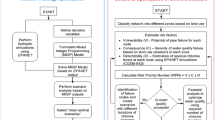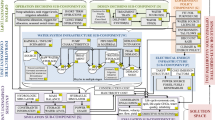Abstract
This paper presents the design of a large water system within the production and packaging areas of a brewery. In order to accomplish the task, mathematical models were developed based on a Mixed Integer Nonlinear Programming (MINLP) formulation from the open literature. These models enable the investigation of several integration options: a) direct water re-use between batch and semi-continuous consumers operating within the same time interval and b) regeneration re-use options, by designing and scheduling an on-site wastewater treatment system.
A multilevel strategy was applied for this large-scale industrial problem, which firstly decomposes design problem into several smaller integration problems concerning water consumers within each section of the brewery. At the following level, water re-use and regeneration re-use opportunities between the brewhouse and the packaging areas were explored for each working day. Finally, the design of an integrated water system was performed over the entire working week by fixing identified intra-daily matches between sections. An optimum water integration scheme is proposed based on the results obtained.
Similar content being viewed by others
References
Alva-Argaez A, Kokossis AC, Smith R (2007) The design of water-using systems in petroleum refining using a water-pinch decomposition. Chem Eng J 128(1):33–46
Bai J, Feng X, Deng C (2007) Graphically based optimization of single-contaminant regeneration reuse water systems. Chem Eng Res Des 85(8):1178–1187
Bai J, Feng X, Deng Ch (2010) Optimal design of single-contaminant regeneration reuse water networks with process decomposition. AIChE J 56(4):915–929
Braeken L, Van der Bruggen B, Vandecasteele C (2004) Regeneration of brewery waste water using nanofiltration. Water Res 38(13):3075–3082
BREF (2006) Reference document on best available techniques in the food, drink and milk industries. European Commission, Seville
Chang CT, Li BH (2005) Improved optimization strategies for generating practical water-usage and -treatment network structures. Ind Eng Chem Res 44(10):3607–3618
Chen C, Lee J, Ng DKS, Foo DCY (2009) Synthesis of property-based water-using networks in batch process industries. In: Chemical engineering transactions, vol 18, pp 695–700. doi:10.3303/CET0918113
de Faria DC, de Souza AAU, de Souza SMAGU (2009) Optimization of water networks in industrial processes. J Clean Prod 17(9):857–862
Doubla A, Laminsi S, Nzali S, Njoyim E, Kamsu-Kom J, Brisset JL (2007) Organic pollutants abatement and biodecontamination of brewery effluents by a non-thermal quenched plasma at atmospheric pressure. Chemosphere 69(2):332–337
EBC (1990) Manual of good practice: water in brewing. European Brewery Convention, Nürnberg
Faria DC, Bagajewicz MJ (2008) A new approach for design of multicomponent water/wastewater networks. Comput-Aided Chem Eng 25:43–48
Feng X, Bai J, Zheng X (2007) On the use of graphical method to determine the targets of single-contaminant regeneration recycling water systems. Chem Eng Sci 62(8):2127–2138
GAMS Beta 22.4 (2007) The solver manuals. GAMS Development Corporation, Washington
Goers B, Mey J, Wozny G (2000) Optimised product and water recovery from batch-production rinsing waters. Waste Manag 20(8):651–658
Gomes JFS, Queiroz EM, Pessoa FLP (2007) Design procedure for water/wastewater minimization: single contaminant. J Clean Prod 15(5):474–485
Gunaratnam M, Alva-Argez A, Kokossis A, Kim JK, Smith R (2005) Automated design of total water systems. Ind Eng Chem Res 44(3):588–599
Huang C, Chang C, Ling H, Chang C (1999) A mathematical programming model for water usage and treatment network design. Ind Eng Chem Res 38(7):2666–2679
Hul S, Tan RR, Auresenia J, Fuchino T, Foo DCY (2007) Water network synthesis using mutation-enhanced particle swarm optimization. Process Saf Environ Prot 86(6):507–514
Iancu P, Plesu V, Lavric V (2009) Waste water network retrofitting through optimal placement of regeneration unit. Chemical Engineering Transactions 18:851–856. doi:10.3303/CET0918139
Jödicke G, Fischer U, Hungerbühler K (2001) Wastewater reuse: a new approach to screen for designs with minimal total costs. Comput Chem Eng 25(2–3):203–215
Karuppiah R, Grossmann IE (2006) Global optimization for the synthesis of integrated water systems in chemical processes. Comput Chem Eng 30(4):650–673
Kim JK, Smith R (2004) Automated design of discontinuous water systems. Process Saf Environ Prot 82(B3):238–248
Kuo W, Smith R (1998) Designing for the interactions between water use and effluent treatment. Trans Inst Chem Eng 76(3):287–301
Li LJ, Zhou RJ, Dong HG (2010) State-time-space superstructure-based MINLP formulation for batch water-allocation network design. Ind Eng Chem Res 49(1):236–251
Liao Z, Huo C, Wu J, Wang J, Jiang B, Yang Y (2007) Conceptual approach for targeting water allocation networks. J Chem Ind Eng, China 58(9):2281–2287 (in Chinese)
Liu Y, Li G, Wang L, Zhang J, Shams K (2009a) Optimal design of an integrated discontinuous water-using network coordinating with a central continuous regeneration unit. Ind Eng Chem Res 48(24):10924–10940
Liu Z, Li Y, Liu Z, Wang Y (2009b) A simple method for design of water-using networks with multiple contaminants involving regeneration reuse. AIChE J 55(6):1628–1633
Luo Y, Yuan X (2008) Global optimization for the synthesis of integrated water systems with particle swarm optimization algorithm. Chin J Chem Eng 16(1):11–15
Matijaševic L, Spoja D, Dejanovic I (2010) Water system integration by the process superstructure development. Chemical Engineering Transactions 21:373–378. doi:10.3303/CET1021063
Ng DKS, Foo DCY (2009) Automated targeting technique for single-impurity resource conservation networks—Part 1 and 2. Ind Eng Chem Res 48(16):7637–7661
Poplewski G, Jezowski JM (2005) Stochastic optimization based approach for designing cost optimal water networks. Comput-Aided Chem Eng 20(A):727–732
Poplewski G, Walczyk K, Jezowski J (2010) Optimization-based method for calculating water networks with user specified characteristics. Chem Eng Res Des 88(1A):109–120
Putra ZA, Amminudin KA (2008) Two-step optimization approach for design of a total water system. Ind Eng Chem Res 47(16):6045–6057
Takama N, Kuriyama T, Shiroko K, Umeda T (1980) Optimal water allocation in a Petroleum Refinery. Comput Chem Eng 4(4):251–258
Tan RR, Col-long KJD, Foo DCY, Hul S, Ng DKS (2008) A methodology for the design of efficient resource conservation networks using adaptive swarm intelligence. J Clean Prod 16(7):822–832
Tokos H, Novak Pintarič Z (2009) Synthesis of batch water network for a brewery plant. J Clean Prod 17(16):1465–1479
Ulson de Souza AA, Forgiarini E, Brandão HL, Xavier MF, Pessoa FLP, Guelli U. de Souza SMA (2009) Application of Water Source Diagram (WSD) method for the reduction of water consumption in petroleum refineries. Resour Conserv Recycl 53(3):149–154
Van der Bruggen B, Braeken L (2006) The challenge of zero discharge: from water balance to regeneration. Desalination 188(1–3):177–183
Vijayaraghavan K, Ahmad D, Lesa R (2006) Electrolytic treatment of beer brewery wastewater. Ind Eng Chem Res 45(20):6854–6859
Xu D, Hu Y, Hau B, Wang X (2003) Minimization of the flowrate of fresh water and corresponding regenerated water in water-using system with regeneration re-use. Chin J Chem Eng 11(3):257–263
Author information
Authors and Affiliations
Corresponding author
Rights and permissions
About this article
Cite this article
Tokos, H., Pintarič, Z.N. Development of a MINLP model for the optimization of a large industrial water system. Optim Eng 13, 625–662 (2012). https://doi.org/10.1007/s11081-011-9162-2
Received:
Accepted:
Published:
Issue Date:
DOI: https://doi.org/10.1007/s11081-011-9162-2




